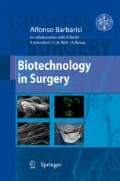Abstract
Wounds today remain a difficult clinical problem due to early or late complications that are a frequent cause of mortality. To try to resolve this problem, many studies have focused on understanding physiologic healing and wound care, with particular emphasis on new therapeutic approaches and the continued development of biotechnology for the management of acute and long term injuries. Normal wound healing is a dynamic and complex process involving a series of coordinated events, including bleeding, coagulation, initiation of an acute inflammatory response to the initial injury, regeneration, migration and proliferation of connective tissue and parenchyma cells, as well as synthesis of extracellular matrix proteins, remodeling of new parenchyma and connective tissue and collagen deposition. Lastly, increasing wound strength takes place in an ordered manner and culminates in the repair of severed tissues [1.
Access this chapter
Tax calculation will be finalised at checkout
Purchases are for personal use only
Preview
Unable to display preview. Download preview PDF.
References
Velnar T, Bailey T, Smrkoly V (2009) The wound healing process: an overview of the cellular and molecular mechanisms. J Int Med Res 37:1528–1542
Sartelli M (2008) The use of floseal haemostatic sealant in surgical haemorrhage. In: Sartelli M, Catena F (eds) Emergency surgery manual. Alpes, Rome, pp. 617–626
Izzo F, Di Marzo M, Idà ND, Piccirillo M (2008) Hemostat, adhesives and sealants: the biomaterials. In: Sartelli M, Catena F (eds) Emergency surgery manual. Alpes, Rome, pp. 611–616
Spotnitz DW (2010) Fibrin sealant: past, present, and future: a brief review. World J Surg 34:632–634
Spotnitz WD, Burks S (2008) Hemostats, sealants, and adhesives: components of the surgical toolbox. Transfusion 48:1502–1516
Seyednejad H, Imani M, Jamieson T, Seifalian AM (2008) Topical haemostatic agents. Brit J Surg 95:1197–1225
Gibble JW, Ness PM (1990) Fibrin glue: the perfect operative sealant Transfsion 30:741–747
Martinowitz U, Schulman S (1995) Fibrin sealant in surgery of patients with a hemorrhagic diathesis. Thromb Haemostasis 74:486–492
Radosevich M, Goubran HA, Burnouf T (1997) Fibrin sealant: scientific rationale, production methods, properties, and current clinical use. Vox Sang 72:133–143
Alving BM, Weinstein JS, Finlayson JE et al (1995) Fibrin sealant: summary of a conference on characteristics and clinical use. Transfusion 35:783–790
Dunn CJ, Goa KL (1999) Fibrin sealant: a review of its use in surgery and endoscopy. Drugs 58:863–886
Kjaergard HK, Fairbrother JE (1996) Controlled clinical studies of fibrin sealant in cardiothoracic surgery. A review. Eur J Cardithorac Surg 10:727–733
Panyam EJ, Labhasetwar V (2003) Biodegradable nano-particles for drug and gene delivery to cells and tissue. Adv Drug Del Rev 55:329–347
Powell JS (2007) Liposomal approach towards the development of a longer-acting factor VIII. Haemophilia 13[Suppl 2]:23–28
Marsh JN, Senpan A, Hu G et al (2007) Fibrin-targeted perfluorocarbon nanoparticles for targeted thrombolysis. Nanomed 2:533–543
Chenglong D, Yuan Y, Changsheng L et al (2009) Degradable, antibacterial silver exchanged mesoporous silica spheres for hemorrhage control. Biomaterials 30:5364–5375
Ellis-Behnke RG, Liang YX, Tay DK et al (2006) Nano hemostat solution: immediate hemostasis at the nanoscale. Nanomedicine 2:207–215
Aust MC, Knobloch K, Reimers K (2010) Percutaneous collagen induction therapy: an alternative treatment for burn scars. Burns doi:10.1016/j.burns.2009.11.014
Hanson SE, Bentz ML, Hematti P (2010) Mesenchymal stem cell therapy for nonhealing cutaneous wounds. Plast Reconstr Surg 125:510–516
Jeong JH (2010) Adipose stem cells and skin repair. Curr Stem Cell Res Ther 5:137–140
Hong YM, Loughlin KR (2006) The use of hemostatic agents and sealants in urology. J Urology 176:2367–2374
Lee LT, Kwan PC, Chen YF, Wong YK (2008) Comparison of the effectiveness of autologous fibrin glue and macroporous biphasic calcium phosphate as carriers in the osteogenesis process with or without mesenchymal stem cells. J Chin Med Assoc 71:66–73
Author information
Authors and Affiliations
Editor information
Editors and Affiliations
Rights and permissions
Copyright information
© 2011 Springer-Verlag Italia
About this chapter
Cite this chapter
Grimaldi, A., Rosso, F., Barbarisi, A. (2011). Biotechnological Approaches to Hemostasis and Molecular Mechanisms of Wound Healing. In: Barbarisi, A. (eds) Biotechnology in Surgery. Updates in Surgery, vol 0. Springer, Milano. https://doi.org/10.1007/978-88-470-1658-3_7
Download citation
DOI: https://doi.org/10.1007/978-88-470-1658-3_7
Publisher Name: Springer, Milano
Print ISBN: 978-88-470-1657-6
Online ISBN: 978-88-470-1658-3
eBook Packages: MedicineMedicine (R0)

